Low nitrogen fertilizer plays a pivotal role in the art and science of bonsai care, where precision in fertilization can mean the difference between a thriving miniature tree and a lackluster specimen.
In the world of bonsai, each element of care is magnified due to the delicate balance required to maintain these miniature marvels. Fertilization, particularly, is a critical aspect that demands attention and specificity.
While nitrogen is a fundamental nutrient promoting foliage and stem growth, in the bonsai realm, the use of low nitrogen plant food is often a strategic choice. It caters to the specific needs of bonsai trees, especially during stages where less vigorous growth is desirable, such as when refining the tree’s shape or during certain seasonal periods.
This article will delve into the nuanced application of low nitrogen plant foods, providing enthusiasts with a detailed guide to perfecting this essential component of bonsai nurturing.
Through understanding the subtleties of bonsai fertilization needs, we will explore how a carefully calibrated approach can lead to the cultivation of stunning bonsai displays that resonate with vitality and aesthetic harmony.
Understanding Bonsai Fertilization Needs
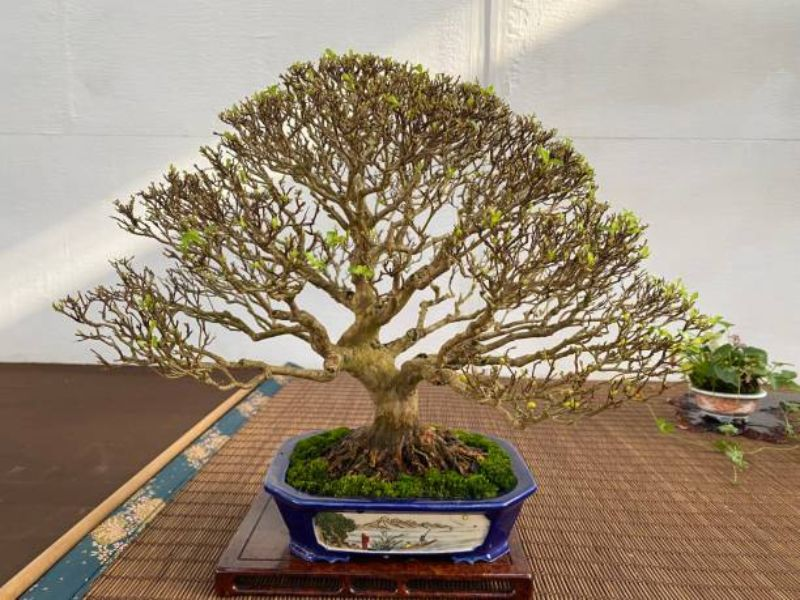
The journey of bonsai care is a delicate dance with nature, where understanding the unique nutritional needs of these miniature trees is crucial.
Bonsai, unlike their full-sized counterparts, grow in limited soil and hence have restricted access to naturally occurring nutrients. This limitation makes the role of the caretaker pivotal in providing a balanced diet through fertilization.
Nitrogen, one of the primary macronutrients in plant fertilization, plays a significant role in the development and care of bonsai. It is fundamentally responsible for the growth of leaves and stems and is a key component of chlorophyll, the substance that gives plants their green color and enables photosynthesis.
However, the application of nitrogen in bonsai care must be a calibrated affair. While high nitrogen fertilizers can lead to lush and vigorous growth, such growth is not always desired in bonsai cultivation.
The goal in bonsai is often to maintain or refine the tree’s current form rather than encourage new or rapid growth. That’s where low nitrogen plant foods come into play. They provide sufficient nitrogen to maintain the health of the bonsai without promoting the excessive plant growth that can disrupt the tree’s carefully cultivated shape. It’s about fostering a balance that supports the bonsai’s health while maintaining its miniature aesthetic.
For instance, during the growing season, a balanced approach may be beneficial to support development. Conversely, in the lead-up to the dormant season, reducing nitrogen helps prepare the plant for a period of rest. Each species of bonsai may also have its own specific requirements, further emphasizing the importance of a tailored fertilization regimen.
The Case For Low Nitrogen Fertilizers
The strategic use of a low nitrogen fertilizer is a testament to the thoughtful care bonsai trees necessitate. These specialized fertilizers come with many benefits crucial for the nuanced demands of bonsai cultivation.
In the world of these miniature trees, excessive growth is not always a boon. It can result in an oversized canopy or overly long internodes that disrupt the desired proportion and symmetry. Low-nitrogen plant foods provide a solution, offering just enough of this essential nutrient to sustain the tree’s health without encouraging the vigorous growth that can distort years of meticulous shaping.
One of the primary benefits of low nitrogen plant foods is their ability to support bonsai trees in maintaining developed structures and mature foliage. During the post-flowering period or as the growing season winds down, it is particularly beneficial to switch to a low nitrogen blend. This shift aids in hardening off the growth that occurred in the spring and summer, ensuring the tree is robust enough to withstand the dormancy of winter.
Furthermore, in cases where a bonsai is recovering from stress—be it from repotting, pruning, or any other intensive care—low nitrogen plant foods support recovery without overwhelming the tree with rapid new growth that it cannot sustain. This careful approach allows for gradual improvement in vigor and stability, which is essential for the recovery process.
Another important situation where low nitrogen plant food is preferred is when refining an already established bonsai. Here, the objective is not to grow but to improve the definition and detailing of the tree.
The low nitrogen content helps in fostering a finer leaf size, a critical element in the aesthetic of bonsai, where every minute detail is amplified and contributes to the overall impact of the miniature landscape.
Types Of Low Nitrogen Plant Foods
Navigating the world of low nitrogen plant foods reveals a diverse landscape of options, each with its own set of characteristics that can be leveraged to support bonsai health. These fertilizers come in two broad categories: organic and inorganic.
Understanding the forms and functions of each is essential for bonsai enthusiasts who wish to make informed decisions about their fertilization strategies.
Organic Fertilizers
Organic fertilizers are derived from natural sources such as plant material, animal waste, or minerals. They are often favored for their slow-releasing properties, which provide a steady supply of nutrients over time. Common organic low nitrogen options include bone meal, cottonseed meal, and composted manures.
These natural fertilizers not only supply nitrogen at low levels but also contribute to the overall soil health by improving its structure and fostering beneficial microbial activity.
However, the nutrient content in organic fertilizers can vary significantly from batch to batch, and they typically take longer to break down and become available to the plant.
Inorganic Fertilizers
Inorganic plant foods are synthetically manufactured and contain minerals or synthetic chemicals. They offer a more consistent nutrient profile and can be quickly absorbed by plants. Examples include ammonium sulfate and calcium nitrate, which can be specifically formulated to have a lower nitrogen content. Inorganic options are favored for their precision and immediate impact.
However, they do not improve soil structure or microbial activity and can lead to salt buildup in the soil if not used judiciously.
Organic Vs. Inorganic: A Balancing Act
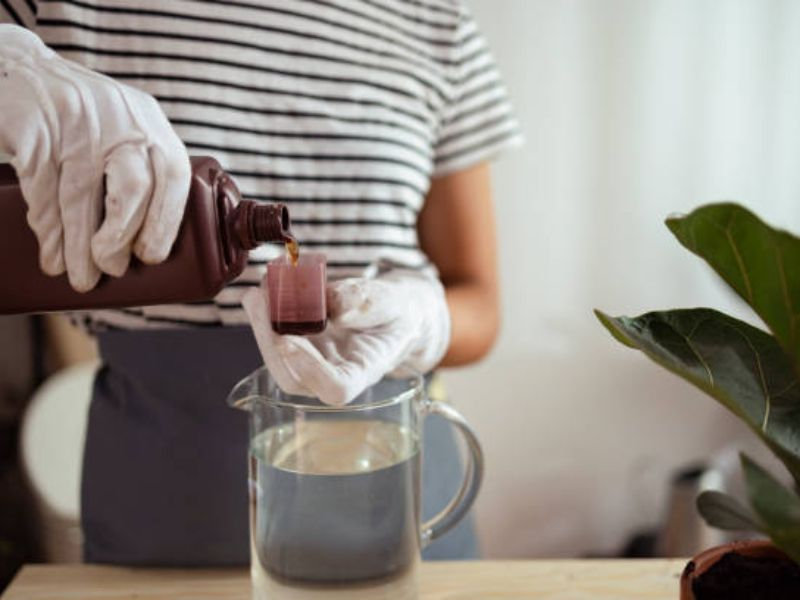
Each type of low nitrogen plant food comes with its own advantages and limitations. Organic fertilizer promotes a healthy soil ecosystem and are generally more sustainable, but require more foresight due to their slow-release nature. Inorganic plant foods provide immediate results and precise nutrient management but lack the long-term soil health benefits and require careful application to avoid potential root burn or environmental harm.
The choice between organic and inorganic low nitrogen plant foods will depend on the specific needs of the bonsai, the preferences of the grower, and the desired outcome. A balanced approach, sometimes combining both types, can often yield the best results, ensuring that the bonsai receives the nutrients it needs while maintaining the health of the soil and respecting the natural growth patterns of these exquisite miniature trees.
Mixing Your Own Low Nitrogen Plant Food
Creating a bespoke low nitrogen plant food mix for your bonsai is both an art and a science. This comprehensive guide will walk you through the steps to craft a blend that meets the nuanced needs of your miniature trees, ensuring they receive the right balance of nutrients to flourish.
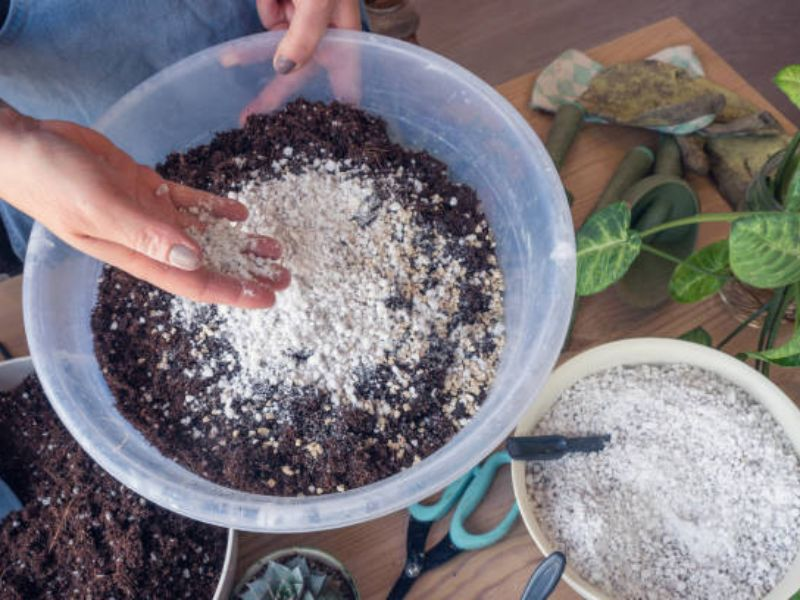
Understanding the Nutrient Ratio
The nutrient ratio of fertilizer is denoted by three numbers representing nitrogen (N), phosphorus (P), and potassium (K), respectively. For a low nitrogen mix, the first number should be lower than those representing phosphorus and potassium. An example ratio could be 5-10-10, which is suitable for promoting root and flower development without excessive leaf growth.
Selecting The Base Ingredients
For organic blends, start with ingredients like bone meal or rock phosphate for phosphorus and greensand or potassium sulfate for potassium. To keep the nitrogen content low, use a smaller amount of a nitrogen source like blood meal or fish emulsion.
Mixing The Ingredients
Measure the ingredients based on the desired N-P-K ratio and mix them thoroughly. For a 5-10-10 mix, you might combine 1 part blood meal, 2 parts bone meal, and 2 parts greensand. It’s important to mix the components evenly to ensure consistent nutrient distribution.
Testing the Mix
Before applying your mix to your bonsai, it’s wise to test it on a few plants to observe the response. Look for signs of healthy growth or any adverse reactions, adjusting the formula as needed.
Application
Apply your custom fertilizer sparingly, as bonsai are sensitive to over-fertilization. Sprinkle the mix around the base of the plant or incorporate it into the top layer of soil. Water the bonsai after application to help the nutrients seep into the soil.
Monitoring And Adjusting
Monitor your bonsai’s response to the fertilizer. Signs of healthy growth include a moderate increase in leaf size and a deepening of color. If the bonsai shows signs of stress or burn, you may need to adjust the mix to lower the nitrogen content further.
By mixing your own low nitrogen fertilizer, you gain control over what goes into your bonsai’s diet, allowing you to tailor the nutrients to the tree’s current needs.
Adapting Fertilizer Mixes To Bonsai Species And Seasons
Tailoring your low nitrogen plant food mix to the specific species of bonsai and the changing seasons is essential for maintaining the delicate equilibrium that these miniature trees demand. Each species of bonsai may have different fertilization requirements, and these can change not only with the seasons but also with the stages of growth and health of the tree.
Seasonal Adaptation
The changing seasons bring about significant shifts in a bonsai’s growth patterns and needs. In the vigorous growth phase of spring, a balanced fertilizer may be appropriate to support new foliage and root development.
As summer progresses, reducing nitrogen levels can help strengthen the growth that has occurred. In autumn, a low nitrogen mix further helps in preparing the bonsai for the dormant winter period, fortifying it against the cold.
Species-Specific Requirements
Bonsai species vary in their nutritional demands. Deciduous trees might benefit from a gradual reduction in nitrogen as they prepare to shed leaves, whereas evergreens, such as pines and junipers, which grow throughout the year, may require a consistent but low application of nitrogen to avoid unnecessary growth spurts.
Growth Stage Considerations
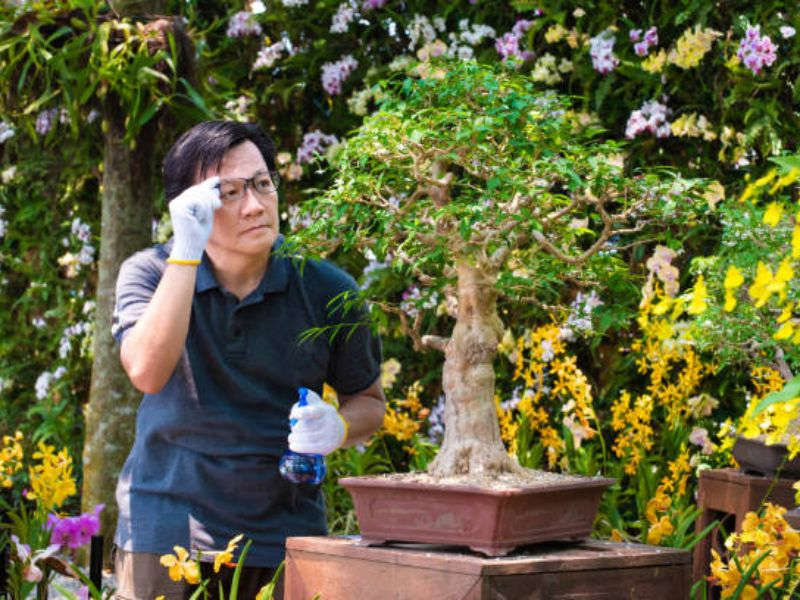
A young bonsai in the training phase may need a slightly higher nitrogen level to establish its form, but as it matures, the focus shifts to maintaining its shape, warranting a low nitrogen approach. Favor a mild, low nitrogen fertilizer after repotting to facilitate the bonsai’s recovery, avoiding the stimulation of undue growth.
Health Indicators
The health of your bonsai is a direct indicator of its fertilization needs. A tree showing signs of yellowing leaves or slow growth may require a slight increase in nitrogen, while a bonsai with lush, overly vigorous foliage might benefit from a reduction.
Adjusting your low nitrogen plant food mix in response to these variables is a nuanced process. It requires careful observation, a willingness to adapt, and a respect for the natural cycles of the bonsai.
Application Techniques
Applying your mixed low nitrogen plant food correctly is as important as the mix itself. Expert advice often boils down to a simple tenet: understanding the nuances of your bonsai’s needs. Different application techniques can be used depending on the form of fertilizer—solid or liquid—and each has its own set of benefits.
Solid Fertilizer Application
Solid fertilizers, such as granules or pellets, are applied to the soil surface and gradually release nutrients as they break down. The key to their effective use lies in even distribution to avoid nutrient hotspots that can burn the roots. Sprinkle the fertilizer around the perimeter of the pot, away from the trunk, to encourage root growth towards the nutrients.
This method is slow-releasing, which suits the bonsai’s need for a gradual nutrient intake and reduces the risk of over-fertilization.
Liquid Fertilizer Application
Liquid fertilizers, such as those available in commercial fertilizer options, are diluted in water and applied directly to the soil, allowing for quick absorption. They’re especially useful for giving your bonsai a gentle nutrient boost. When using liquid fertilizers, it’s essential to apply them during watering to prevent root burn and ensure even distribution.
The frequency of application of substances such as ammonium nitrate will be more frequent than with solids, but the concentration will be lower, offering a controlled approach to nourishing your bonsai.
Foliar Feeding
Foliar feeding is the practice of applying a diluted fertilizer solution directly to the leaves. While not a primary method of fertilization for bonsai, it can be beneficial for providing micronutrients. Since bonsai leaves are small, care must be taken to apply a very fine mist to prevent leaf burn.
Root Drenching
Root drenching is reserved for times when the bonsai is in need of a significant nutrient uptake. This method involves pouring a diluted liquid fertilizer solution over the soil until it begins to run out of the drainage holes. It ensures deep soil penetration and can be particularly useful after repotting to encourage root recovery.
Incorporating Into The Watering Schedule
A balanced approach is to incorporate fertilizer application into the regular watering schedule. This helps prevent the disruption of the bonsai’s growth rhythm and maintains consistent nutrient availability.
Regardless of the method, it is crucial to follow the bonsai’s response and adjust accordingly. Fertilizer should be applied during the active growth period and reduced or stopped during the dormant period.
Timing And Frequency Of Fertilization
Determining the optimal timing and frequency for applying low nitrogen fertilizers is critical to the health and development of your bonsai. The goal is to synchronize your fertilization schedule with the natural growth cycles of the plant, ensuring maximum effectiveness and avoiding waste or potential damage.
Seasonal Timing
Bonsai trees, like all indoor plants, have seasonal cycles. In spring, as the bonsai exits dormancy, it’s a good time to start with a balanced fertilizer to support new growth. As the growth slows down by mid-summer, transitioning to a low nitrogen fertilizer helps in strengthening the matured growth.
As fall approaches, proactively decrease or cease fertilization to aid the tree’s transition into energy-saving dormancy.
Growth Phase Frequency
Apply a low nitrogen fertilizer to bonsai every 4-6 weeks throughout spring and summer, the peak growing season, with vigilant control over nitrogen levels.
The frequency should be adjusted based on the species, with some requiring more frequent feeding and others less. Vigilance is key; observe the bonsai’s growth and health as indicators for when to fertilize.
A slow growth or pale leaves may suggest the need for a slight increase in frequency or nutrient concentration.
Environmental Considerations
Environmental factors such as temperature, light, and humidity also influence the fertilization schedule. In high temperatures, bonsai may require more frequent watering, which can leach nutrients from the soil, necessitating a slightly increased frequency of fertilization. Reduce fertilization frequency in response to the bonsai’s slower nutrient uptake due to cooler temperatures or diminished light.
Bonsai’s Response
The bonsai’s response is the most direct indicator of the effectiveness of your fertilization schedule, whether you’re using low or high nitrogen fertilizer. Lush, dark green foliage indicates good health, whereas yellowing or dropping leaves suggest an imbalance. Actively fine-tune fertilization practices, consistently choosing less rather than more fertilizer to protect bonsai from the risks of over-fertilization.
Consistency Is Key
While adjustments may be necessary, it’s important to maintain as much consistency as possible. Sudden changes can stress the bonsai, so any modifications to the fertilization schedule should be made gradually. Maintaining a regular, documented schedule can help you track the bonsai’s health and growth over time, making it easier to make informed adjustments.
Conclusion
Fertilizing bonsai requires a nuanced approach, balancing growth with form. Low nitrogen fertilizer is essential in this delicate dance, ensuring your bonsai develops robustly without compromising its intricate shape. At Leaves and Soul, we provide the essentials for this task—quality soils and fertilizers tailored for the bonsai aficionado. Embrace the precision that bonsai care demands with our trusted products, and watch your miniature landscapes flourish into serene, soulful masterpieces.


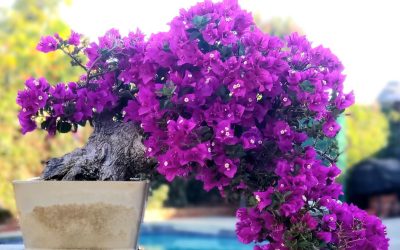
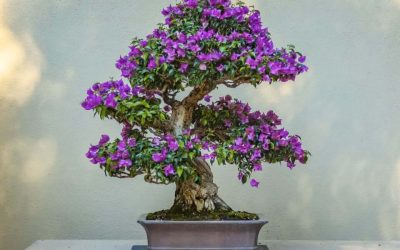
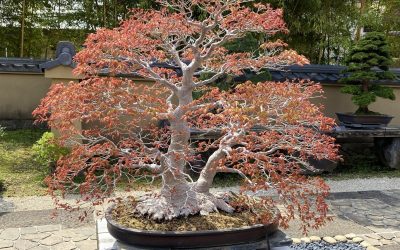
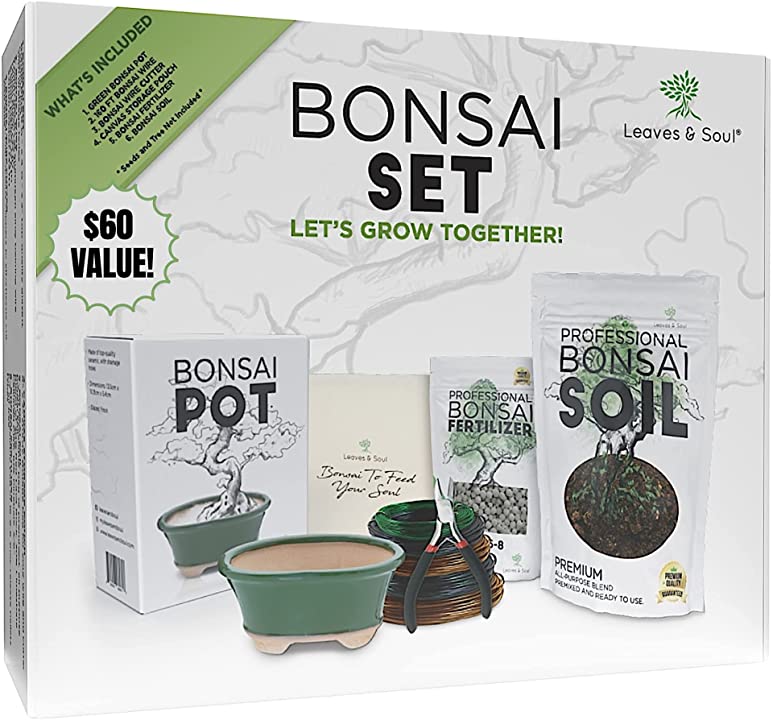
0 Comments